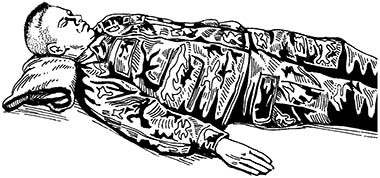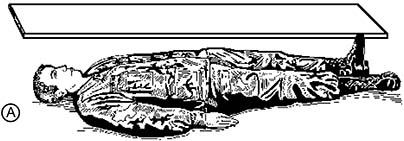4-11. Neck Fractures
A fractured neck is extremely dangerous. Bone fragments may bruise or cut the spinal cord just as they might in a fractured back.
- a. If the casualty is not to be transported until medical personnel arrive —
-
- • Caution him not to move. Moving may cause permanent injury or death.
- • Leave the casualty in the position in which he is found. If his neck and head (cervical spine) are in an abnormal position, immediately immobilize the neck and head.
-
- • Keep his head still, if the casualty is lying face up, raise his shoulders slightly, and slip a roll of cloth that has the bulk of a bath towel under his neck (Figure 4-31). The roll should be thick enough to arch his neck only slightly, leaving the back of his head on the ground. DO NOT bend his neck or head forward. DO NOT raise or twist his head. Immobilize the casualty’s head (Figure 4-32). Do this by padding heavy objects (such as rocks or his boots filled with dirt, sand, gravel, or rock) and placing them on each side of his head. If it is necessary to use boots, after filling them, tie the top tightly or stuff with pieces of cloth to secure the contents.)
 Figure 4-30. Casualty with roll of cloth
Figure 4-30. Casualty with roll of cloth (
bulk)
under neck.
 Figure 4-31. Immobilization of fractured neck.
Figure 4-31. Immobilization of fractured neck.
-
-
- • DO NOT move him if the casualty is lying face down. Immobilize the head and neck by padding heavy objects and placing them on each side of his head. DO NOT put a roll of cloth under the neck. DO NOT bend the neck or head, nor roll the casualty onto his back.
- b. If the casualty must be prepared for transportation before medical personnel arrive —
-
- • If the casualty has a fractured neck, at least two persons are needed because the casualty’s head and trunk must be moved in unison. The two persons must work in close coordination (Figure 4-32) to avoid bending of the neck.
- • A wide board is placed lengthwise beside the casualty. It should extend at least 4 inches beyond the casualty’s head and feet (Figure 4-32A).
- • If the casualty is lying face up, the number one man steadies the casualty’s head and neck between his hands. At the same time, the number two man positions one foot and one knee against the board to prevent it from slipping. He then grasps the casualty underneath his shoulder and hip and gently slides him onto the board (Figure 4-32B).
- • If the casualty is lying face down, the number one man steadies the casualty’s head and neck between his hands, while the number two man gently rolls the casualty over onto the board (Figure 4-32C).
- • The number one man continues to steady the casualty’s head and neck. The number two man simultaneously raises the casualty’s shoulders slightly, places padding under his neck, and immobilizes the casualty’s head (Figures 4-32D — E).
- • Any improvised supports are secured in position with a cravat or strip of cloth extended across the casualty’s forehead and under the board (Figure 4-32D).
- • The board is lifted onto a litter or blanket in order to transport the casualty (Figure 4-32E).
 Figure 4-32. Preparing casualty with fractured neck for transportation
Figure 4-32. Preparing casualty with fractured neck for transportation (
Illustrated A — E)
.
 Figure 4-32. Preparing casualty with fractured neck for transportation
Figure 4-32. Preparing casualty with fractured neck for transportation (
Illustrated A — E) (
Continued)
.




